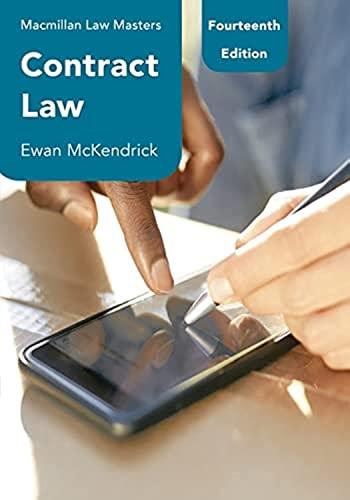Question
Organization & Structure: Generally, you can organize your paper into four broad sections. An introduction that captures the attention of the reader. The historical context:
Organization & Structure:
Generally, you can organize your paper into four broad sections.
- An introduction that captures the attention of the reader.
- The historical context: What is the current state of the law and why is there a problem?
- Change proposal: What do you suggest we do about this problem and why is your proposal better than other possible approaches?
- A conclusion that summarizes the current state of the law, your proposal and why your proposal should be considered.
The paper needs to be organized into discrete sections which include a few paragraphs as an introduction to the educational law issue. Try to start your paper with a quote, a stat, or a significant event; something to capture the attention of the reader.
Provide several paragraphs that describe the historic context of the issue and the current state of the law. Try to outline the various viewpoints that have evolved or emerged as it relates to the education law issue. Try to identify any changes to the law that have recently impacted or are about to impact the topic selected. For example, is there an important case on the docket of the Supreme Court? Is there a newly released guidance from the Department of Education or proposed changes in the regulations that impact your topic? Are there bills under consideration in your state legislature that could potentially change the legal landscape? How will these changes impact the legal issue under consideration?
Provide a statement of the problem that explains why this issue is important. Sometimes this is referred to as the "so what test." The writer needs to explain to the reader why this issue is important and worthy of consideration. Explain what should be done to address the issue of concern or what will happen if various courses of action are adopted.
Develop an analysis of what will happen in the future and what school officials or policy makers should do to address the important issue.
Provide concluding thoughts that summarize the current state of the law, outline your proposal, and explain why your approach should be considered.
Include a title page with the title of your paper, your name, Education Law 689, Spring 24.
The title page and the reference page or citations do not count in the page total.
Sources & Citations:
One of the skills developed in graduate school is the capacity to synthesize multiple resources into a coherent and succinct commentary. I am not going to set a specific number of references or resources that must be used, but a 7-10-page research paper on a contemporary area of education law should include more than just a few sources.
You are free to use some of the related content found in the course materials, but additional research into your topic must be evident.
If you are going to include a quote from one of your resources, remember quotes need page numbers.
I prefer you use either APA or the uniform citation system, but I am willing to allow other formats if the paper adequately cites the sources and is organized into a professional format.
Formatting:
Your paper should use the following formatting:
- Use headings for the various sections of your paper.
- Use New Times Roman size 12 or a similar font.
- Each page should be double spaced with one-inch margins.
- Page numbers and running heads are also expected.
Grading Criteria:
I will grade this paper according to the following criteria:
- The organization of the paper.
- The quality of the writing.
- The depth of understanding relating to the educational law issue under consideration as shown by the paper's content.
- Does the paper show substantial research over and above what was provided in the course materials?
- Are the sources used in the paper adequately cited?
- Is the proposal realistic and embedded in the historical context of the legal issue?
- Does the author support their proposal with sound and logical reasoning?
Possible Topics:
Possible topics include but are not limited to:
- Teacher off-campus activities that lead to termination.
- The teaching of critical race theory in public schools.
- Transgender student participation athletic activities.
- The removal of books from public school libraries.
- The pros and cons of an increased police presence on school campuses.
- The Second Amendment and armed-teacher policies in public schools.
- Enforcing the use of preferred pronouns in public schools.
- The pros and cons of vouchers in public schools along with a list of states that use vouchers and for what purpose
- Laws applicable to charter schools in your state.
- Explain the laws associated with funding and constructing public schools.
- How states are addressing school funding.
- Teacher religious expression in the wake of Kennedy v. Bremerton.
- The most common legal mistakes made by school officials in special education cases.
- The increasing tension between parents and school boards.
- Identify and describe the laws that private elementary and secondary schools must abide by.
- An analysis of student privacy as it relates to student electronic devices.
- The use of emotional support animals at school
- State authority over home schooling
Step by Step Solution
There are 3 Steps involved in it
Step: 1

Get Instant Access to Expert-Tailored Solutions
See step-by-step solutions with expert insights and AI powered tools for academic success
Step: 2

Step: 3

Ace Your Homework with AI
Get the answers you need in no time with our AI-driven, step-by-step assistance
Get Started


